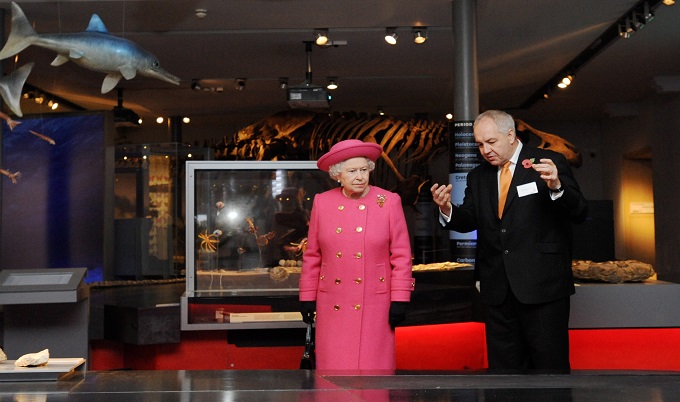Tribute to HM Queen Elizabeth
A lifetime of service and duty
Published on: 12 September 2022
Dr Martin Farr reflects on the life of Queen Elizabeth II.
It could not have been more appropriate that the last public photograph of Queen Elizabeth II was taken two days before her death and was of her undertaking official duties. Indeed, she was performing perhaps her single most important duty: inviting a Prime Minister to form a government. Duty may be regarded as defining her reign.
Outgoing and incoming Prime Ministers having to make round trips to Balmoral from Westminster in this second week of September 2022 was an indication both of continuity – Liz Truss is the Queen’s fifteenth premier; the first was Winston Churchill – and change: in 1974 she flew from Australia to be in Buckingham Palace in time to receive the Prime Minister.
That it was always known this moment would come does little to diminish its impact, even for those who may feel little or no personal or political sympathy with the Queen as a person, the Royal Family as an institution, or monarchy as a constitutional arrangement. The announcement of her death will be a moment few who know of it will forget, almost as imperishable as the memory of the moment of their meeting will remain for the many who met her.
A reign of length spans change. In the case of Elizabeth II, such change was not just in the events but in their acceleration. The ‘new Elizabethan era’, as it was called in the early 1950s, was also the ‘jet age’; seventy years later she negotiated a global pandemic by co-opting video conferencing, just as her father had embraced radio broadcasts in the 1930s. It was clear that 2022’s jubilee – her seventieth – would be her last; there is unlikely ever to be another Platinum regal celebration.
Monarchs are accidental, are creations of circumstance, but some more than others. Initially she had no expectation of serving. One of the many remarkable aspects of the Queen’s reign is that it produced the two most experienced public figures in the world – Elizabeth II and Charles III – but did so only because in 1936 her uncle, Edward VIII, declined to make the sacrifices required by his station, and abdicated.
So much of her reign was in the manner of that of her father, thrust into the role by an older brother who did not value duty. George VI passed the spirit of service to his daughter, who succeeded him in 1952. The Queen was not by nature a reformer, but was open to change; her father was perfectly happy with a Labour government and a welfare state under Clement Attlee in 1945. No longer Emperor of India, portraiture presented him as head of a middle class family.
The Sovereign’s ascendancy derived from leading by example, beginning with the young adult in uniform in the Second World War – with which she was almost our last connection – a war which framed her life, as it tended to for those who lived through it. It reflected broader social change that though her purpose was principally public service, her descendants were increasingly viewed through the lens of celebrity. Prince Philip’s 1969 Royal Family documentary came to be regretted – too much ‘daylight’ let in upon ‘magic’ – while the twenty-first century paring of the family into ‘working royals’, and the centrality of the line of succession, pointed to its intended future.
A measure of the achievement or effectiveness of a public figure is the nature and tenor of the criticism they receive. It is hard ever to have discerned any directed at the Queen personally. To have been so prominent for so long without arousing or attracting significant controversy in an age of intensifying scrutiny and diminishing deference is not the least of her achievement. Hers was originally an imperial crown, but she died in a multi-faith, multi-ethnic, democracy that seemed content with a hereditary monarchy.
A critic could present a narrative of ‘crown in crisis’, of rows and scandals – some of the worst the most recent – yet the closest the Queen came to political controversy was the appointment of the Prime Minister in 1963 (and that was not made public), or her words in 2014 – “I hope people will think very carefully about the future” – concerning Scottish independence. She forbore the disintegration of the empire she pledged to serve, and leaves a fragile Union.
The shift in register from reticence to emotionalism was perhaps the hardest to process, and occasioned such mis-steps as the delay before visiting Aberfan, in 1966, and the silence over Princess Diana, in 1997. And thus the surprise in hearing her publicly describe 1992 as her “annus horribilis”. But the extreme uncertainties and convulsions in national life of the last years of her reign arguably enhanced her appeal, her constancy. Her socially-distanced mourning of Prince Philip in 2021 became one of the defining scenes in what had been a year of trauma. The depth of public sentiment to come may surprise.
With the familiarity there was mystery. Hers is the most reproduced image in history (29 billion coins in UK circulation alone; she declined Postmaster General Tony Benn 1965’s invitation to no longer appear on postage stamps) but was also publicly mute. Someone so well-known remained unknown: she never gave an interview, nor commented to the press. Her speeches were written by her ministers. An annual televised Christmas message was the extent of her voice, which made her 2020 address to a country beleaguered by pandemic the more inspiriting. She was Head of the Commonwealth and Defender of the Faith, but comfortable enough to appear before the world, separately, with James Bond and Paddington Bear.
In the longest adult reign in history there was, until the end, authority in restraint. “I declare before you all”, she said on her twenty first birthday, “that my whole life whether it be long or short shall be devoted to your service and the service of our great imperial family to which we all belong.” As antiquated as aspects now sound, the essence remained undimmed. She would never resign, she would never abdicate. She did not.
Even – perhaps especially – a dedicated republican would be pressed to deny (not least as she made their cause harder) that if one were to conceive of the ideal constitutional monarch, that sovereign would approximate Elizabeth II as closely as possible. The genius of this institution – approve of it or not as one may – has been in its recasting of itself from being defined by power to being characterised by service. The Queen reigned but did not rule; public support was maintained. How much that was due to her will soon be known.
Dr Martin Farr, Senior Lecturer in Contemporary British History




